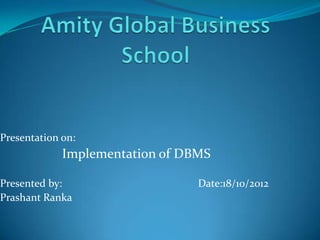Implementation of dbms
•Transferir como PPTX, PDF•
5 gostaram•7,008 visualizações
The document presents on the implementation of a database management system (DBMS). It defines a DBMS as software that controls the creation and use of a database, allowing different programs to access the same database simultaneously. It describes the key components of a DBMS, including the DBMS engine, data definition subsystem, data manipulation subsystem, and application generation subsystem. The presentation outlines advantages such as a centralized warehouse of information, data security, and consistency. It provides tips for implementing a DBMS, such as identifying necessary data elements, setting data access permissions, testing the system, educating users, and evaluating the system after deployment.
Denunciar
Compartilhar
Denunciar
Compartilhar

Recomendados
Mais conteúdo relacionado
Mais procurados
Mais procurados (20)
2-Tier and 3-Tier Architecture of Enterprise Resource Planning

2-Tier and 3-Tier Architecture of Enterprise Resource Planning
Destaque
Destaque (9)
Marketing Automation at Scale: How Marketo Solved Key Data Management Challen...

Marketing Automation at Scale: How Marketo Solved Key Data Management Challen...
Meaning,nature,scope,process of management & approaches of a system

Meaning,nature,scope,process of management & approaches of a system
Semelhante a Implementation of dbms
Semelhante a Implementation of dbms (20)
Mais de Prashant Ranka
Mais de Prashant Ranka (8)
Último
Último (20)
General Principles of Intellectual Property: Concepts of Intellectual Proper...

General Principles of Intellectual Property: Concepts of Intellectual Proper...
Jual Obat Aborsi Hongkong ( Asli No.1 ) 085657271886 Obat Penggugur Kandungan...

Jual Obat Aborsi Hongkong ( Asli No.1 ) 085657271886 Obat Penggugur Kandungan...
UGC NET Paper 1 Mathematical Reasoning & Aptitude.pdf

UGC NET Paper 1 Mathematical Reasoning & Aptitude.pdf
Beyond_Borders_Understanding_Anime_and_Manga_Fandom_A_Comprehensive_Audience_...

Beyond_Borders_Understanding_Anime_and_Manga_Fandom_A_Comprehensive_Audience_...
HMCS Vancouver Pre-Deployment Brief - May 2024 (Web Version).pptx

HMCS Vancouver Pre-Deployment Brief - May 2024 (Web Version).pptx
Fostering Friendships - Enhancing Social Bonds in the Classroom

Fostering Friendships - Enhancing Social Bonds in the Classroom
On National Teacher Day, meet the 2024-25 Kenan Fellows

On National Teacher Day, meet the 2024-25 Kenan Fellows
Basic Civil Engineering first year Notes- Chapter 4 Building.pptx

Basic Civil Engineering first year Notes- Chapter 4 Building.pptx
Python Notes for mca i year students osmania university.docx

Python Notes for mca i year students osmania university.docx
Micro-Scholarship, What it is, How can it help me.pdf

Micro-Scholarship, What it is, How can it help me.pdf
Implementation of dbms
- 1. Presentation on: Implementation of DBMS Presented by: Prashant Ranka Date:18/10/2012
- 2. What is DBMS ? A database management system (DBMS) is a software package with computer programs that controls the creation, maintenance, and use of a database. It allows organizations to conveniently develop databases for various applications. A database is an integrated collection of data records, files, and other objects. A DBMS allows different user application programs to concurrently access the same database
- 3. Components: DBMS engine accepts logical requests from various other DBMS subsystems, converts them into physical equivalents, and actually accesses the database and data dictionary as they exist on a storage device. Data definition subsystem helps the user create and maintain the data dictionary and define the structure of the file in a database. Data manipulation subsystem helps the user to add, change, and delete information in a database and query it for valuable information. Software tools within the data manipulation subsystem are most often the primary interface between user and the information contained in a database. It allows the user to specify its logical information requirements. Application generation subsystem contains facilities to help users develop transaction-intensive applications. It usually requires that the user perform a detailed series of tasks to process a transaction. It facilitates easy-to-use data entry screens, programming languages, and interfaces.
- 4. Advantages: Warehouse of Information Defining Attributes Systematic Storage Changes to Schema No Language Dependence Table Joins Multiple Simultaneous Usage Data Security Abstract View of Data and Easy Retrieval Data Consistency
- 6. 1. Identify all the elements that need to be included in the database management system. This will vary depending on the size and type of your business. At the very least, you will need to be able to access data on raw and finished goods inventories, customer information, shipment tracking, employee data and Accounts Receivable and Payable data. Knowing what you need will make it easier to include all important elements in the DBMS.
- 7. 2. Set perimeters for access to data. Not all employees need to have access to all data. This means establishing login credentials for all employees and setting up a hierarchy of privileges associated with each set of credentials. For larger companies, this usually means establishing specific privileges for a job or position. In smaller companies, the authorizations may focus more on the individual employee and less on the position.
- 8. 3. Test drive the new DBMS. Before pressing the new database management system into service, run it for a period of time outside your “real” business by running it through all the projected applications. Enter data, run reports, look up histories, run queries, and conduct any other intended uses of the system. This will provide the chance to correct any small issues with functionality before the system goes live.
- 9. 4. Educate all users. This can often be the most time consuming part of the implementation process, outside the offline testing. If the processes are well defined and fairly straightforward, then the learning curve will be a relatively short one. Making sure that all users understand how to use the new DBMS will minimize downtime and other issues that are commonly associated with a new implementation.
- 10. 5. Evaluate the system after it has been up and running for a time. This is an aspect that is often overlooked as part of the implementation process. After running the system live, ask users to evaluate the ease of use and to recommend ways that the system could be used to make life easier for everyone in the company
